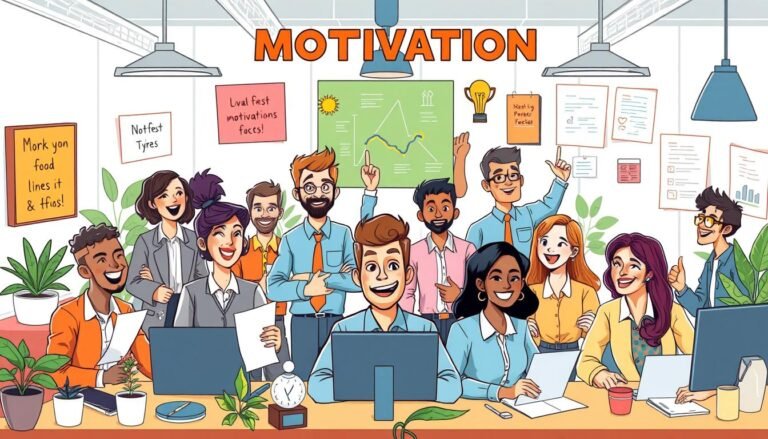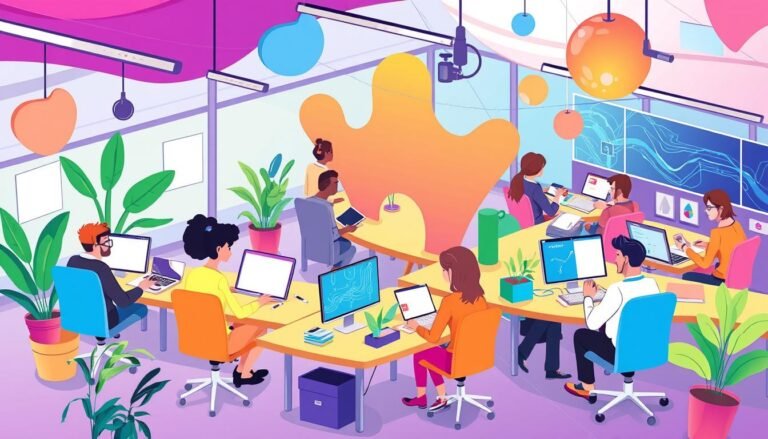Talent Mobility and Internal Career Paths
In today’s fast-paced business world, talent mobility and internal career paths are hot topics. Companies are realizing the importance of nurturing their workforce from within. This approach boosts employee satisfaction and drives business growth.
Recent studies show that 82% of high-growth companies have lost talent due to lack of career development opportunities. This startling statistic highlights the urgent need for robust talent mobility strategies. In response, over 70% of companies increased their investment in talent mobility in 2023.
Workforce planning now focuses on skills rather than job titles. A whopping 95% of surveyed companies prioritize skills when promoting employees. This shift marks a new era in career pathing, where versatility and adaptability take center stage.
The benefits of internal career development are clear. High-performing companies report improved employee retention, diversity, and overall employee experience. These outcomes underscore the value of investing in talent mobility programs.
Key Takeaways
- 82% of high-growth companies lose talent due to lack of career development
- 70% of companies increased talent mobility investment in 2023
- 95% of companies prioritize skills over job titles for promotions
- Talent mobility improves retention, diversity, and employee experience
- Internal career paths are crucial for employee engagement and satisfaction
Understanding Talent Mobility and Its Importance
Talent mobility is a key strategy for modern organizations. It involves moving employees between roles, departments, or locations within a company. This approach benefits both employees and employers, fostering growth and innovation.
Defining Talent Mobility
Talent mobility includes vertical and horizontal movements. Vertical mobility means climbing the career ladder, while horizontal mobility involves switching to different roles at the same level. Both types play a crucial role in employee development and skills mapping.
Key Benefits for Organizations
Organizations gain numerous advantages from implementing talent mobility strategies:
- Enhanced employee retention
- Improved succession planning
- Cost-effective talent acquisition
- Increased workplace diversity
Studies show that employees who move into new roles internally are 3.5 times more likely to be engaged. This engagement translates to longer tenures, with staff staying almost twice as long when companies invest in internal mobility programs.
The Role of Employee Engagement
Employee engagement is crucial for successful talent mobility. When staff feel valued and see growth opportunities, they’re more likely to stay. In fact, 68% of workers would remain with their employer throughout their career if given upskilling chances.
| Factor | Impact on Retention |
|---|---|
| Great Onboarding | 69% more likely to stay for 3 years |
| Internal Mobility | 2x longer employee tenure |
| Upskilling Opportunities | 68% would stay long-term |
By focusing on talent mobility, companies can create a dynamic workforce ready to face future challenges while boosting employee satisfaction and retention rates.
Internal Career Paths: What Are They?
Internal career paths let employees grow within a company. They focus on Career Progression, offering many ways to improve skills and positions. Let’s look at the types of internal career paths and how they help employees grow.
Types of Internal Career Paths
Companies have different paths for Career Progression:
- Vertical mobility (promotions)
- Horizontal mobility (lateral moves)
- Cross-functional mobility (moving between departments)
Career Latticing is a newer idea. It lets employees move in many directions, growing their skills and experiences.
The Importance of Job Rotations
Job Rotations are key in internal career paths. They let employees try different roles or departments. This helps them learn more and find where they shine.
Career Development vs. Career Advancement
These terms are often mixed up, but they mean different things:
| Career Development | Career Advancement |
|---|---|
| Focuses on personal growth and skill acquisition | Typically involves moving up the organizational hierarchy |
| Can include lateral moves and learning new skills | Often associated with promotions and increased responsibilities |
| Emphasizes long-term growth and versatility | Focuses on short-term gains in position and salary |
Knowing these differences helps in making better career plans. It lets both employees and managers explore and plan for growth within the company.
The Link Between Talent Mobility and Retention
Talent mobility is key to keeping employees and planning your workforce. Companies that focus on career growth keep their top talent. Let’s look at how mobility helps with retention and the costs of high turnover.
How Mobility Improves Employee Retention
A study found that 73% of employees want to learn about new roles in their company. This desire matches well with good talent mobility plans. By offering clear career paths, companies meet employees’ needs and lower turnover.
Workers without clear career paths are 61% more likely to leave. This shows how important it is to have open career development programs.
Real-World Examples of Success
Top companies have great talent mobility programs. Some hold internal career fairs to let employees see different paths. Others give skill-based certifications and mentorship, making employees happier and more likely to stay.
The Cost of High Turnover Rates
High turnover costs a lot for companies. Here are some numbers:
| Factor | Impact |
|---|---|
| Employees interested in internal opportunities | 73% |
| Workers expecting employers to prioritize internal hiring | 66% |
| Employees who would stay if career opportunities were visible | 90% |
| Managers supporting internal candidate priority | 72% |
These numbers show how talent mobility can cut down on turnover costs. By investing in career growth and internal moves, companies can build a more dedicated team.
Building a Culture of Talent Mobility
Creating a workplace that values Talent Mobility is key. It fosters Internal Career Development and boosts Employee Engagement. Companies that focus on learning see 218% higher revenue per employee. This shows the value of investing in your workforce.
Strategies for Encouraging Mobility
To build a culture of talent mobility, organizations can:
- Promote internal hiring opportunities
- Implement regular development reviews
- Enhance the candidate experience for internal applicants
These strategies can lead to a 25% increase in innovation and creativity. Only 6% of companies excel at developing internal mobility cultures. There’s a lot of room for growth.
Leadership Engagement in Talent Mobility
Leadership is crucial in fostering talent mobility. Department directors should actively share growth opportunities with their teams. This can lead to a 20% increase in employee retention rates.
The Role of Communication
Effective communication is vital for a successful talent mobility program. Organizations should:
- Clearly advertise internal positions
- Conduct regular surveys for feedback
- Implement mechanisms to assess and improve the talent mobility culture
Despite its importance, only 27% of employees feel their company effectively communicates internal opportunities. By improving communication, companies can see a 20% increase in employee engagement levels.
“Talent mobility is not just about moving people around; it’s about creating a culture of continuous learning and growth.”
Identifying Talent Mobility Opportunities
It’s key to spot talent mobility chances for good Skills Mapping and Career Progression. Firms that focus on moving talent around see big wins. Their employees stick around almost twice as long as those who don’t get these chances.
Assessing Employee Skills and Aspirations
Skills Mapping means checking what employees can do now and what they want to do next. It uncovers skills gaps and growth spots. Regular check-ins and surveys help figure out what employees dream of, helping plan for the future.
Leveraging Internal Talent Analytics
Using data to guide talent moves is crucial. Tools like skills databases and performance stats help find the right fit for employees. These tools uncover talents and paths that might surprise everyone.
Recognizing Potential Future Leaders
Finding future leaders is vital for Succession Planning. By looking at how well they do and their leadership potential, companies can grow talent from within. This approach keeps things running smoothly and makes employees happier and more likely to stay.
| Internal Mobility Benefits | Statistics |
|---|---|
| Employee Retention | 2x longer tenure |
| Engagement Improvement | Double-digit increase |
| Internal Hiring Rate | 24% of total hires |
| Promotion Likelihood | 7% higher with training |
By working on Skills Mapping, Career Progression, and Succession Planning, companies can build a strong talent strategy. This strategy helps both the employees and the company thrive.
Training Programs to Facilitate Mobility
Companies now see how important training programs are for talent mobility. They know that keeping top talent is key to a skilled workforce. With 51% of workers looking for new jobs, it’s crucial to focus on internal growth.
Skills Development Initiatives
Skills mapping helps find gaps and create training plans. Companies that invest in skills see big benefits. In fact, 48% of workers would change jobs for more training.
This shows how important learning opportunities are for keeping employees.
Mentorship and Coaching Approaches
Mentorship is vital for career growth. It pairs experienced staff with new talent. This helps in sharing knowledge and developing leaders.
It also supports succession planning, a priority for 49% of companies.
E-Learning and Digital Resources
Digital learning platforms make growth easy and accessible. Many use AI to match employees with learning chances. These tools can boost promotions by 20% in a year with tailored plans.
By investing in training, companies can cut down on turnover. Those with strong internal hiring see employees stay 41% longer. This shows the link between growth chances and loyalty.
Overcoming Challenges in Talent Mobility
Talent mobility in today’s workplace faces many hurdles. A recent study shows that 50% of employees find it easier to get jobs outside their company than within. This highlights the need for better Workforce Planning and Internal Career Development strategies.
Common Barriers to Mobility
Organizations often find it hard to move talent around. 22% of employees say lateral moves are discouraged, and 44% say there are no internal positions. These issues show how important Career Pathing is.
Strategies to Address Resistance
To beat these challenges, companies need to act proactively. It’s key to educate and motivate managers, as 29% of executives make it hard for internal candidates to apply. Creating systems that reward overall company success can align managers’ goals with talent mobility.
Best Practices for Implementation
For talent mobility programs to succeed, a culture shift is needed. Josh Bersin, CEO of The Josh Bersin Company, stresses the importance of motivating employees to grow within the company. It’s crucial to communicate clearly about career opportunities, as 74% of workers want to know about internal openings. By following these best practices, companies can foster a great environment for Internal Career Development and Workforce Planning.
- Educate managers on the benefits of talent mobility
- Create clear pathways for lateral and vertical moves
- Implement robust skills assessment tools
- Foster a culture that values internal mobility
- Regularly review and update mobility programs
The Employer’s Role in Supporting Career Development
Employers are key in helping employees grow in their careers. They can make a big difference by offering clear paths for advancement. This boosts employee happiness and keeps them around longer.
Creating Clear Pathways for Growth
Companies that invest in training keep their employees longer. This shows how important it is to have clear career paths. By showing what the future holds, employers help employees see their place in the company.
Providing Resources and Support
Employers need to give their employees the tools they need to grow. This includes:
- Mentorship programs
- Skills development initiatives
- Cross-functional projects
Most employees think career coaching would make them better at their jobs. Companies with mentorship programs see a big jump in employee happiness and work quality.
Celebrating Internal Moves
It’s important to celebrate when employees move up or sideways. It shows that moving around is valued. Employees who work on different projects are more likely to get promoted, showing the value of trying new things.
“Career mobility strategies serve as catalysts for employee skill enhancement, career fulfillment, and organizational growth.”
By focusing on career growth, employers make their employees feel important and supported. This not only makes employees happier but also helps the company succeed in the long run.
Evaluating the Success of Talent Mobility Programs
It’s key to measure how well talent mobility works. This helps with planning the workforce and keeping employees. Companies must track important numbers and listen to what employees say. This makes sure the programs meet business and employee needs.
Metrics and KPIs to Consider
Companies should look at certain numbers to see if talent mobility is working. They should check how well they fill jobs from within, how long it takes for new hires to start working, and how well employees stick around. Giving employees chances to grow helps keep them happy and loyal.
| Metric | Impact |
|---|---|
| Internal Fill Rate | Shows if they’re using the talent they already have well |
| Retention Rate | Shows how happy and loyal employees are |
| Time-to-Productivity | Shows how fast new hires start doing their job |
Gathering Employee Feedback
It’s important to get feedback from employees. Surveys and interviews can help find ways to make the program better. Companies that listen to their employees tend to have happier and more loyal workers.
Regular Program Reviews and Updates
It’s important to keep checking and updating talent mobility plans. This helps them stay current with the market and what employees want. It also helps with planning the workforce and supports career growth.
“Implementing incentives to reward managers who share high performers across the organization can prevent managerial gatekeeping.”
By always checking and improving talent mobility programs, companies can create a place where employees can grow. This helps both the employees and the company succeed.
Technology’s Role in Talent Mobility
Technology is key in talent mobility today. HR software helps match employees with jobs and boosts Skills Mapping. It makes Career Pathing easier for everyone.
HR Software Solutions for Internal Mobility
Modern HR platforms use AI to connect employees with open roles. They analyze skills and interests to suggest career moves. This speeds up internal hiring and improves Workforce Planning.
Data-Driven Decision Making
HR tech gives leaders key data on talent trends. They can spot skill gaps and plan training. Analytics help predict which employees may leave. This lets companies take action to keep top talent.
The Future of Talent Mobility Technology
AI will play a bigger role in talent mobility. It may offer personalized career advice to workers. Virtual reality could let staff “try out” new roles. As tech evolves, it will make internal moves smoother for all.
| Technology Impact | Benefit |
|---|---|
| AI-Powered Matching | 64% higher retention after 3 years |
| Learning Platforms | 76% of Gen Z see learning as key to advancement |
| Internal Gig Platforms | Align employees with priority projects |
With these tools, companies can build a culture of growth. They empower workers to shape their careers. This leads to higher engagement and better business results.
Success Stories: Companies Excelling in Talent Mobility
Talent mobility has changed the game for many companies. Those that focus on internal growth and keeping employees happy through mobility programs see big wins.
Case Studies of Top Employers
Some companies really get talent mobility right. For example, a top tech firm created an internal job site. This led to a 40% boost in employee happiness.
Another company in finance made a big move. They started a career growth program. This led to a 60% better chance of keeping their best workers.
Key Takeaways from Successful Strategies
What makes talent mobility work? It’s about clear communication, leader support, and investing in skills. Companies that do this well can save up to 80% on hiring costs.
| Strategy | Impact |
|---|---|
| Internal Job Marketplace | 40% increase in engagement |
| Career Progression Program | 60% higher retention rate |
| Talent Mobility Initiatives | 80% savings on hiring costs |
Lessons Learned for Future Growth
Top companies in talent mobility keep learning. They know 82% of employees want to grow their skills more than perks. They also focus on work-life balance, with 89% of employees saying it’s key to happiness.
By focusing on these areas, companies can build a culture that supports career growth and keeps employees for the long haul.
Future Trends in Talent Mobility
The world of talent mobility is changing fast. Career Pathing and Workforce Planning are now key. A survey of 219 companies shows 69% want to focus more on moving talent within in 2024. They see the value in growing their own talent.
The Shift Toward Hybrid Working Models
Remote work is becoming common, and companies are changing their strategies. Hybrid models are changing how people see career growth. But, 50% of employees don’t know about job chances inside their companies. This shows the need for better ways to share information.
Growing Importance of Agile Talent Management
Agile talent management is becoming more important, with keeping talent being a big goal for 2024. Companies are using three ways to share job chances: internal job boards, emails, and talks with managers. This aims to improve job filling rates and make employees happier.
Predictions for Career Path Evolutions
The future of Career Pathing will be about skills, not just titles. Deloitte’s survey says talent mobility is a big trend. With 70% of workers ready to move for better learning, companies must keep up.
Skills shortages are a big problem, costing $1.2 trillion by 2029. So, good Workforce Planning is key to staying ahead.
Source Links
- What Is Internal Mobility, and Why Is It Important?
- Internal talent mobility: Types, benefits, and best practices
- What Is Talent Mobility and How does it Benefit Companies | TalentGuard
- What is Talent Mobility & Why It’s Important | WorkRamp
- Talent mobility: A critical HR imperative | InStride
- Internal Mobility: What Is It and Why Do You Need It? – Gloat
- What is Internal Mobility And Why Do You Need It? – Fuel50
- Talent Mobility: Rethinking Internal Career Paths – Mentessa
- Internal Talent Mobility: The Key to Boosting Engagement and Retention
- Unlocking Talent Mobility: Empowering Employees with Internal Career Growth
- The future of talent mobility through reimagined employee development
- How to Create a Culture of Internal Mobility – Growthspace
- Steps to Build a Culture of Talent Mobility – Spire.AI
- 5 Steps to Building a Culture that Supports Internal Talent Development and Mobility
- Talent Mobility: What It Is and How It Impacts Your Company
- Internal Talent Mobility Programs in Today’s Workplace
- Career and Talent Mobility Course | Josh Bersin Academy
- How to Get Your Internal Mobility Program Started | Together Mentoring Software
- Author Post: Top Barriers to Internal Mobility and How They Can Be Solved
- Career and internal mobility: how to overcome challenges
- 10 Ways to Improve Employee Career Development
- What is Career Mobility & Why It Matters?
- What is an Internal Talent Mobility Strategy and Why You Need One
- Mastering Internal Talent Mobility Strategies for Upskilling Success
- Ten Ways to Boost Internal Talent Mobility | TalentGuard
- Fueling Talent Mobility Initiatives Through Learning Technology | Educe
- Vitro Global
- Internal Mobility vs Talent Mobility: What’s the Difference and Why It Matters | Talent Development Solution | Peoplefluent
- Talent Mobility Creates a Profitable Company
- Talent Mobility Effectiveness with Talent Analytics
- How TA Leaders Are Prioritizing Internal Mobility in 2024 – Veris Insights
- Talent Mobility: Why it Matters to the Future of Your Organization
- 2024 Internal Mobility Trends








